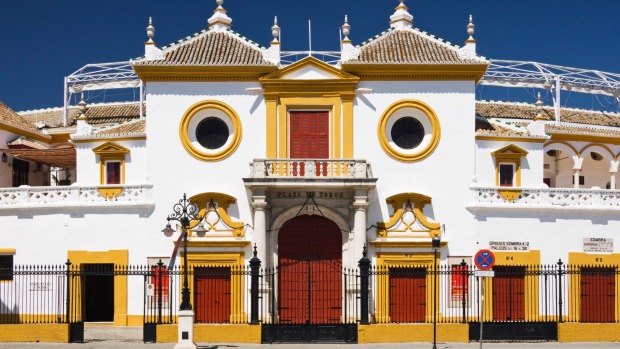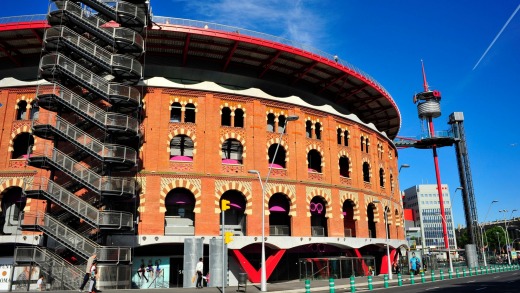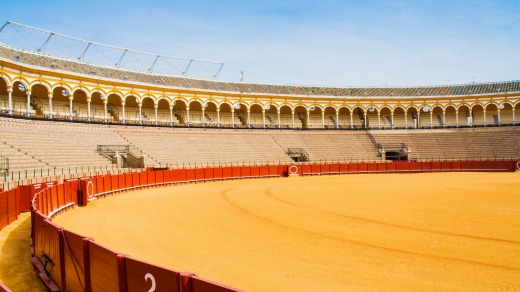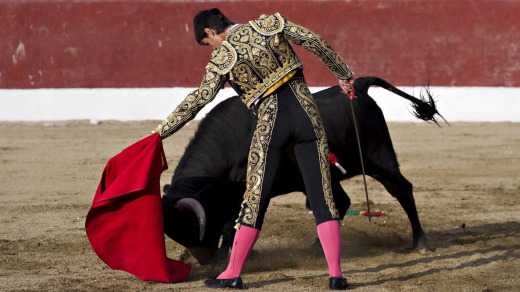
It might be one of the pillars of Spanish culture, but I don't like the idea of bullfighting. Not one bit. Sure, I've seen Blood and Sand probably more than once, drooling over Tyrone Power on the black-and-white TV in the suburban lounge room of my youth. But that epic was 1940s Hollywood, where the heroic matador dies in the arena trying to reclaim his lost title and redeem his tarnished soul.
It's an entirely different story sitting jam-packed on a hot stone bench in sunny Spain where the spectacle unfolds in techno-colour with crowds baying for blood.
On a recent escorted coach tour, I arrive in Madrid during the height of bullfighting season. A few in our group, including two young women, decide to go to a fight. Our tour director, a Portuguese man who tells us that bullfighting also has a long history in his country, warns that it is brutal. I don't need any dissuasion. I am happy to seek out a tapas bar.

The next day the two tell me they were in tears, not prepared for the show's bloody reality. Six bulls, all slaughtered. End of story – €60.
The residents of Madrid, the Madrilenos, apparently love the "sport". I'm sure if you get sucked into the whole heroic Valentino character (that heart-throb also played the fictional matador Juan Gallardo in the 1922 version of the film), it would appear romantic – the flash of the scarlet cape, the glint of the sequinned jacket, the tight breeches and all that.
The Moors ruled for nearly 800 years and left the region with stunning buildings.
What I do like are the bullrings. I adore Arabesque architecture and we can thank the Moorish invasion of Spain in 711 for the design. The Moors ruled for nearly 800 years and left the region with stunning buildings including the Alcazar in Seville, the Mezquita in Cordoba and the show-stopping Alhambra in Granada.

The bullrings of today were mostly built between the 1880s and 1930s in the neo-Mudejar design, a modern take on the Moorish look.
My tour pals headed to Madrid's Plaza de Toros de Las Ventas, considered the home of bullfighting in Spain and the third largest in the world. (Surprisingly the largest bullrings are in Mexico and Venezuela). It can seat 25,000 spectators. Down in Seville, the oldest bullring in Spain – La Maestranza – took about 120 years to finish, from 1730 to 1850. It can take 14,000 fans. Fortunately, both are open for tours where there's no need to see a fight.
While bullfighting is alive and well in Madrid and Andalucía, the love of the toro has lost its mojo in Barcelona. The folks of Catalonia, who've always wanted independence from the rest of Spain, voted to stop the blood sport. The last fight was in September 2011 in the city's La Monumental ring. Then the famous matador, Jose Tomas, was called on to perform at the swan song; unlike Valentino and Tyrone, he survived.

This arena's neo-Mudejar design is so stunning that the Emir of Qatar wants to turn it into a mosque, which would become the world's third largest. The jury is still out on that one.
What is more accessible is Barcelona's other bullring – the Las Arenas in the fantastic Placa d'Espanya. My hotel is across the road and I'm captivated by its grandeur.
Now a hip retail and restaurant space, it underwent a massive renovation by architect Richard Rogers, who designed Paris' Pompidou Centre. , Having fallen into disrepair in the 1970s and standing idle for many years, its deterioration was testament to Catalonia's declining interest in bullfighting known locally as corrida de toros. The beautiful facade was saved but the inside gutted and given an industrial chic look. Bright yellow steel pylons hold up the six levels of shops, cafes and performance spaces, all connected by escalators. Rogers demolished the plinth that the old building had sat on and raised the enormous brick structure on another set of funky, red pylons. He added an extra level at the top of the building that extends beyond the circular walls, which acts as a wraparound promenade deck. He topped off the entire structure with a huge dish-like roof, (a bit like a flying saucer).
The Barcelonans like their rooftop bars and those sheltering under the dish are great. To get to the roof you can take an exterior elevator for €1. And when you get there, what a view! Below is all the drama of the busy square and the crazy drivers. Nearby is the twinkling Magic Fountain of Montjuic and a little further up that hill the grand Museu Nacional d'Art de Catalunya. Walk around the promenade and there are views up to Mount Tibidabo where a statue of Christ stands atop a neo-gothic church. Look down and there is the famous Joan Miro sculpture, Woman and Bird, standing 22 metres high.
What a magnificent spectacle. No blood, no sand. But undoubtedly a dashing Spaniard or two in tight jeans at the bar.
TRIP NOTES
MORE INFORMATION
spain.info
GETTING THERE
Emirates flies daily between Sydney, Melbourne and Madrid, and between Sydney, Melbourne and Barcelona. Fares from about $1800 return. emirates.com
STAYING THERE
The hotel Catalonia Barcelona Plaza is in Placa d'Espanya (or Plaza Espana) across from the Las Arenas former bullring. Rooms from $142 a night; see hoteles-catalonia.com
DINING AND SHOPPING THERE
Las Arenas de Barcelona has dozens of shops, tapas bars and a handful of rooftop bars; see arenasdebarcelona.com.
TOURING THERE
Globus' nine-day "Best of Spain" tours depart from March until December, leaving from Madrid and ending in Barcelona. Prices for 2016 range from $1619 a person; single traveller supplement is $474. Gratuities for the tour director and the driver about $84 a passenger; see globusjourneys.com